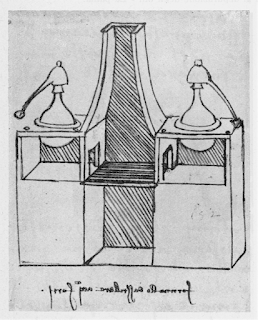His manuscripts include mention of 300 different chemical compounds, and also equipment such as a stove for distilling acqua forte (nitric acid). When we say "distilled" we mean subjected to the process of vaporization and condensation, typically to extract and purify a substance.
 |
| Codex Atlanticus 335 rb (new 912r), c.1479-1480. The text reads "fornello da stillare acque forti" (stove for distilling aqua forte). |
 |
| Codex Atlanticus folio 400 vc (c. 1479-1480). |
- he may have invented it, built it, then sketched it
- he may have invented it (conceived it), but never built it
- he may have seen and sketched someone else's invention
- he may have read about the invention from another source and simply copied the idea
Therefore, regardless of whether Leonardo deserves credit for a particular invention or discovery, we can at least see his thousands of pages of manuscripts as a gateway to the world of Europe 500 to 550 years ago, and we can appreciate what could be known in that time period. And we know there was a vigorous exchange of technological ideas throughout Europe, and beyond.
And what sorts of studies did he do? Leonardo distilled salts from human feces. “Salt may be made from human stool, burnt and calcined and made into lees and dried slowly by fire. And all stools produce salt in a similar way, and these salts when distilled are very penetrating” (Royal Library 12351v). (Calcined means roasted [from calcinare, to heat]; lees refers to sediment, or dregs; this is insoluble matter.) We know that he prepared nitric acid, copper nitrate, and red ferrous oxide.
He also he prepared acetone--the stuff of nail polish remover--and this is thought to be one of his original discoveries. He writes:
“(1) Stilla aceto e la stillatura sua fa passare per la sua feccia nuovamente (2) bruciata e calcinata o (3) falla passare per il tartaro calcinato e poi (4) ristilla e ricalcina il tartaro e fia acqua risolutiva” (Ms. K3, folio 114r, c.1509-1512).
I've added numbers to break down this passage. The source of this analysis is Ladislao Reti (Le arti chimiche di Leonardo da Vinci, La Chimica e l'Industria, Soc. An. Editrice di Chimica, Milan, 1952, pp. 13-14).
(1) Leonardo frequently mentions distilled vinegar. This was done to produce concentrated acetic acid, separated from other constituents of wine (e.g. salts, acids, colors).
(2) Drip vinegar and the dripped material is made to pass through its dregs newly burned to pass through the tartaro calcinato (bitartrate of potassium, tartrate of calcium). Potassium carbonate and some calcium carbonate will form.
(3) The acetic acid will react with the carbon compounds to form a mixture containing potassium acetate, with some calcium acetate.
(4) The potassium acetate and potassium carbonate, heated to a high temperature in a closed vessel, decompose forming acetone (“acqua risolutiva”).
At least, this is my understanding of Ladislao Reti's analysis. (Of course, this is a modern chemical interpretation, and is based on the period table of the elements as introduced in the 19th century--chemistry as we know it today would have been foreign to anyone in earlier centuries.) Nail polish remover in 1509? Apparently so. I wonder if he invented nail polish too--Lomazzo credits Leonardo with the discovery of pastels, so why not.




